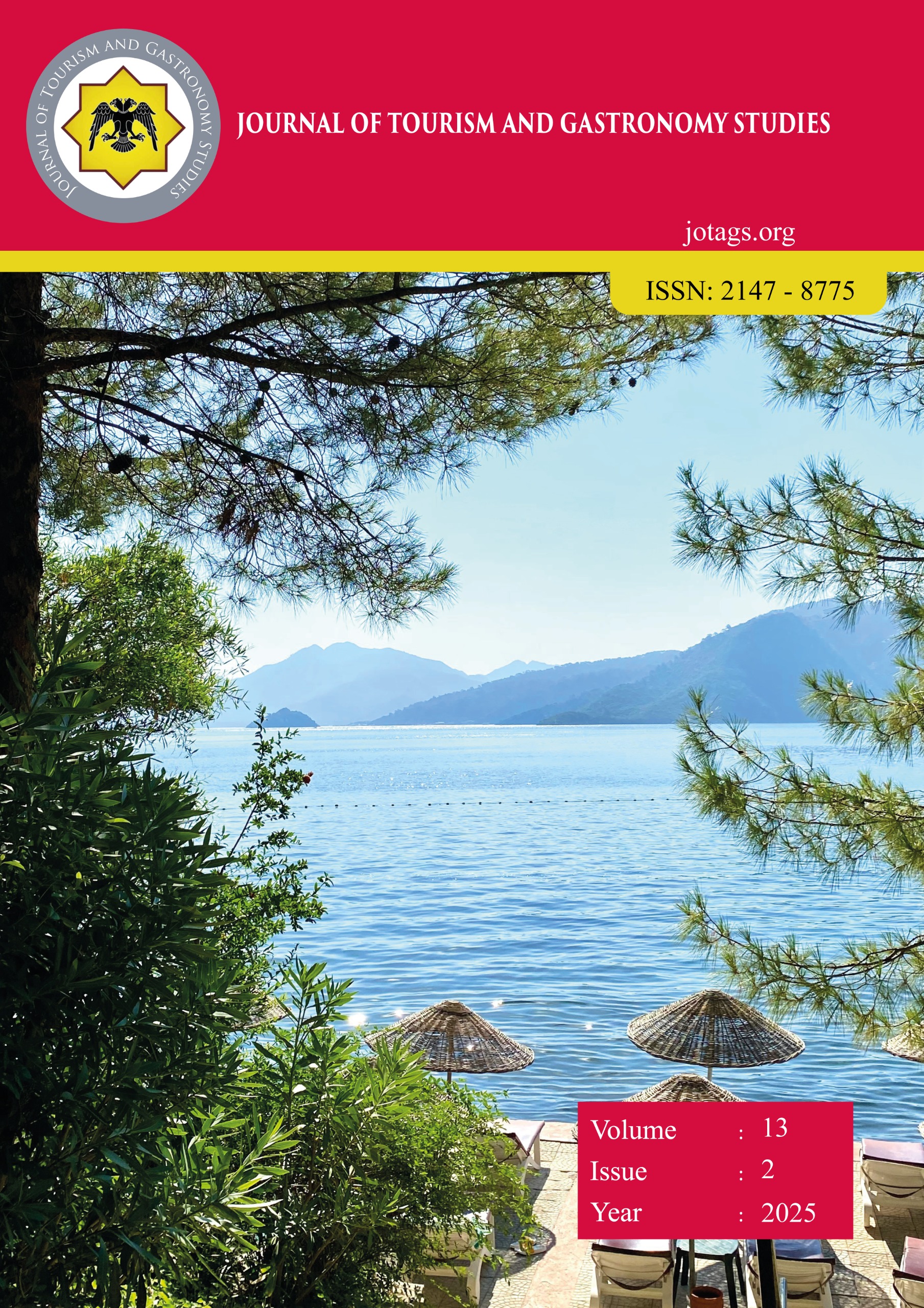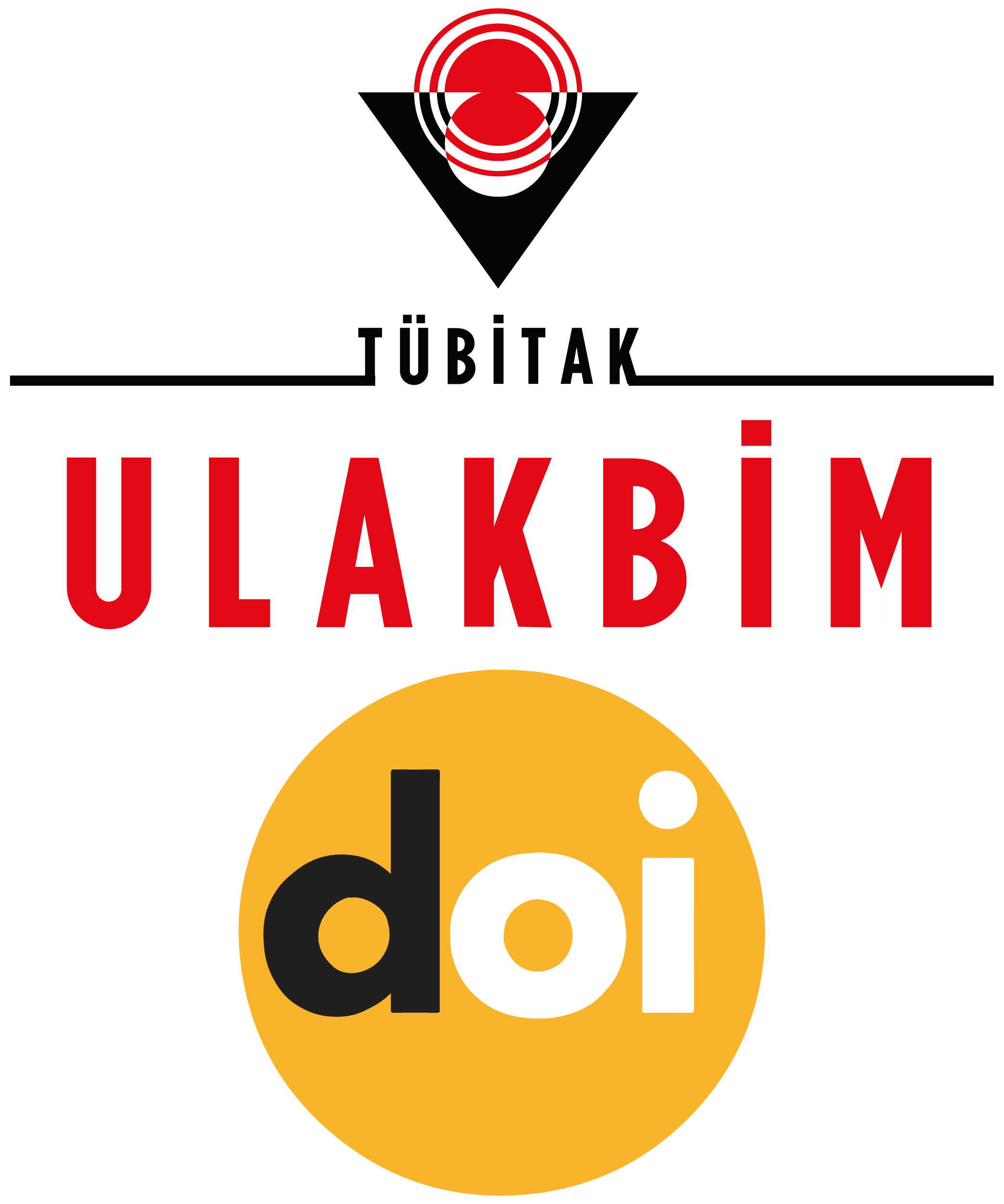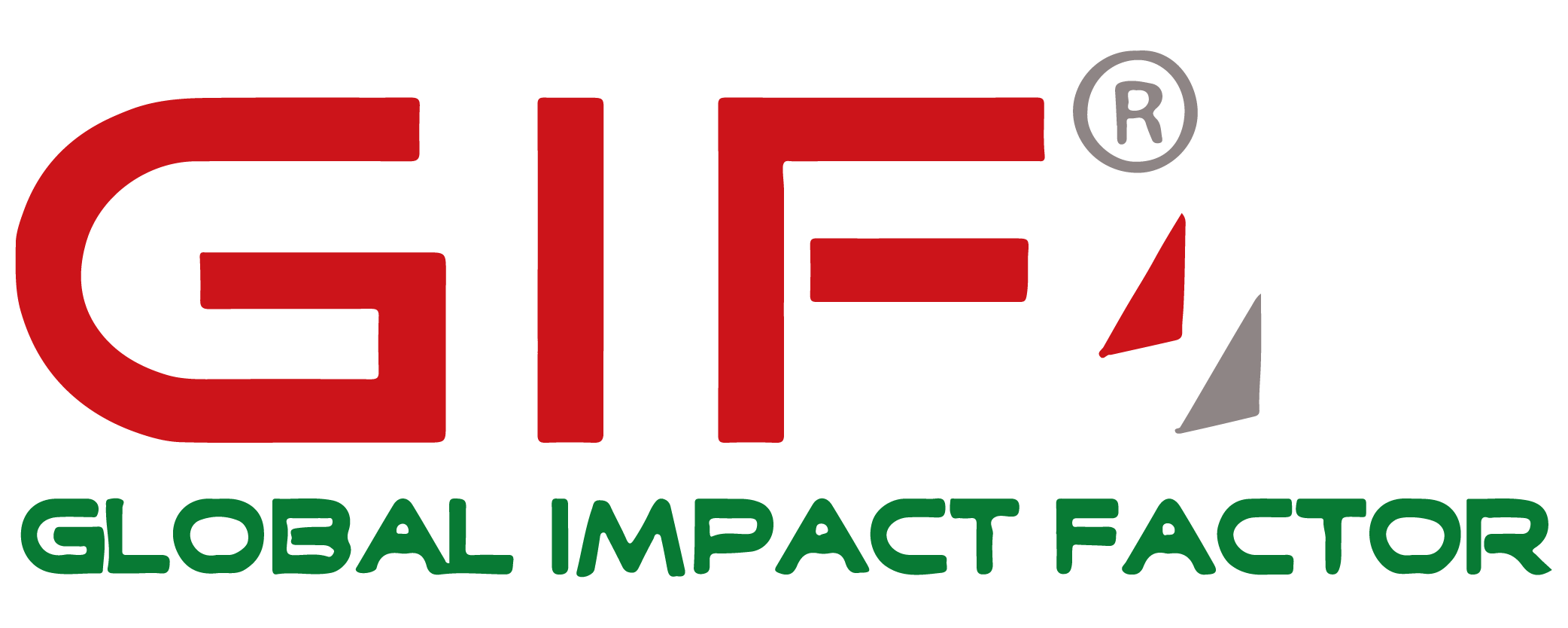Gıda Alerjisi ve Gıda İntoleransı’nın Gastronomik Öneri Boyutlarıyla İncelenmesi (Investigation of Food Allergy and Food Intolerance with Gastronomic Recommendation Dimensions)
DOI:
https://doi.org/10.21325/jotags.2025.1651Keywords:
Food intolerance, Food allergy, Elimination diet, FODMAP dietAbstract
The aim of gastronomy is to provide both delicious and safe meals by maintaining a balance between culinary arts, food, and food allergies. Developing solutions tailored to the needs of individuals with food allergies is an important aspect of gastronomy, emphasizing its role as a field of social responsibility. Within this framework, the purpose of this study is to examine the dietary restrictions caused by food allergies and food intolerances, which adversely affect health, from a gastronomic perspective, thereby contributing scientifically to the literature and consumers. Because food allergies and food intolerances have recently become significant vital issues affecting the lives of many people. In this context, the necessity of completely removing food products that cause sensitivity to food allergies and intolerances from the dietary model has been highlighted. Since this situation may lead to certain dietary restrictions in life, alternative food products have been proposed as substitutes for foods causing sensitivity. These alternatives are recommended not only to prevent allergic reactions but also to address nutritional deficiencies and enhance quality of life. As a result, the study emphasizes the importance of individualizing dietary approaches, making them tailored to the individual. Furthermore, it draws attention to the need for more research on food allergies and intolerances from a sustainable perspective and through multidisciplinary studies.
References
Akay, E., & Yılmaz, İ. (2020). Yeni etiketleme yönetmeliğine göre alerjen gıdalar ve sağlık etkileri. İstanbul Gelişim Üniversitesi Sağlık Bilimleri Dergisi, (12), 443-459.
Akoğlu, A. & Oruç, M. (2018). Metabolik gıda intoleransları. Harran Tarım ve Gıda Bilimleri Dergisi, 22 (2), 284-295.
Alkalay, M. J. (2021). Nutrition in patients with lactose malabsorption, celiac disease, and related disorders. Nutrients, 14(1), 2.
Allen, K. J., Turner, P. J., Pawankar, R., Taylor, S., Sicherer, S., Lack, G., ... & Sampson, H. A. (2014). Precautionary labelling of foods for allergen content: are we ready for a global framework?. World Allergy Organization Journal, 7(1), 1-14.
Asioli, D., Aschemann-Witzel, J., Caputo, V., Vecchio, R., Annunziata, A., Næs, T., & Varela, P. (2017). Making sense of the “clean label” trends: A review of consumer food choice behavior and discussion of industry implications. Food Research International, 99, 58-71.
Bahna, S. L. (2024). History of food allergy and where we are today. World Allergy Organization Journal, 17(5), 100912.
Barnett, J., Muncer, K., Leftwich, J., Shepherd, R., Raats, M. M., Gowland, M. H., ... & Lucas, J. S. (2011). Using'may contain'labelling to inform food choice: a qualitative study of nut allergic consumers. BMC Public Health, 11, 1-9.
Bartha, I., Almulhem, N., & Santos, A. F. (2024). Feast for thought: A comprehensive review of food allergy 2021-2023. Journal of Allergy and Clinical Immunology, 153(3), 576-594.
Bellini, M., Tonarelli, S., Nagy, A. G., Pancetti, A., Costa, F., Ricchiuti, A., ... & Rossi, A. (2020). Low FODMAP diet: evidence, doubts, and hopes. Nutrients, 12(1), 148.
Bianchi, P. I., Aronico, N., Santacroce, G., Broglio, G., Lenti, M. V., & Di Sabatino, A. (2024). Nutritional Consequences of Celiac Disease and Gluten-Free Diet. Gastroenterology Insights, 15(4), 878-894.
Bilaver, L. A., Chadha, A. S., Doshi, P., O'Dwyer, L., & Gupta, R. S. (2019). Economic burden of food allergy: a systematic review. Annals of Allergy, Asthma & Immunology, 122 (4), 373-380.
Boham, E. (2024). IFM’s elimination diet: personalized optimized nutrition. The Institute for Functional Medicine. https://www.ifm.org/articles/heal-the-gut-with-the-ifm-elimination-dietErişim Tarihi: 1 Aralık 2024.
Burbank, A. J., Sood, A. K., Kesic, M. J., Peden, D. B., & Hernandez, M. L. (2017). Environmental determinants of allergy and asthma in early life. Journal of Allergy and Clinical Immunology, 140(1), 1-12.
Caeiro, C., Pragosa, C., Cruz, M. C., Pereira, C. D., & Pereira, S. G. (2022). The role of pseudocereals in celiac disease: reducing nutritional deficiencies to improve well-being and health. Journal of Nutrition and Metabolism, 2022. 1-8
Cafarotti, A, Giovannini, M, Begìn, P, Brough, HA, Arasi, S. (2023). Management of IgE-mediated food allergy in the 21st century. Clin Exp Allergy, 53: 25- 38.
Catanzaro, R., Sciuto, M., & Marotta, F. (2021). Lactose intolerance: An update on its pathogenesis, diagnosis, and treatment. Nutrition Research, 89, 23-34.
Chan, H. H., & Ng, T. (2020). Traditional Chinese medicine (TCM) and allergic diseases. Current Allergy and Asthma Reports, 20, 1-18
Cotton, C. C., Eluri, S., Wolf, W. A., & Dellon, E. S. (2017). Six-food elimination diet and topical steroids are effective for eosinophilic esophagitis: a meta-regression. Digestive Diseases and Sciences, 62, 2408-2420.
Çatak, J., Demirci, A., & Yaman, M. (2021). Besin alerjileri ve mikrobiyota. Avrupa Bilim ve Teknoloji Dergisi, (27), 902-910.
De Falco, B., Amato, M., & Lanzotti, V. (2017). Chia seeds products: an overview. Phytochemistry Reviews, 16, 745-760.
Dekker, P. J., Koenders, D., & Bruins, M. J. (2019). Lactose-free dairy products: market developments, production, nutrition and health benefits. Nutrients, 11(3), 551.
Din, Z. U., Alam, M., Ullah, H., Shi, D., Xu, B., Li, H., & Xiao, C. (2021). Nutritional, phytochemical and therapeutic potential of chia seed (Salvia hispanica L.). Food Hydrocolloids for Health, 1, 100010.1-5.
Du Toit, G., Foong, R. X. M., & Lack, G. (2016). Prevention of food allergy-Early dietary interventions. Allergology International, 65(4), 370-377.
Elghoudi, A., & Narchi, H. (2022). Food allergy in children—the current status and the way forward. World Journal of Clinical Pediatrics, 11(3), 253.
Fiocchi, A., Risso, D., DunnGalvin, A., Díaz, S. N. G., Monaci, L., Fierro, V., & Ansotegui, I. J. (2021). Food labeling issues for severe food allergic patients. World Allergy Organization Journal, 14(10), 100598.
Fleischer, D. M., Chan, E. S., Venter, C., Spergel, J. M., Abrams, E. M., Stukus, D., ... & Greenhawt, M. (2021). A consensus approach to the primary prevention of food allergy through nutrition: guidance from the American Academy of Allergy, Asthma, and Immunology; American College of Allergy, Asthma, and Immunology; and the Canadian Society for Allergy and Clinical Immunology. The Journal of Allergy and Clinical Immunology: In Practice, 9(1), 22-43.
Gallo, A., Pellegrino, S., Lipari, A., Pero, E., Ibba, F., Cacciatore, S., ... & Montalto, M. (2023). Lactose malabsorption and intolerance: What is the correct management in older adults?. Clinical Nutrition, 42(12), 2540-2545.
Gökçen, M., & Küşümler, A. S. (2021). Yetişkinlerde gıda etiketi okuma bilgi düzeyi ile davranışa geçirme arasındaki ilişki. Online Turkish Journal of Health Sciences, 6(1), 82-91.
Groetch, M & Nowak-Wegrzyn, A. (2013). Practical approach to nutrition and dietary intervention in pediatric food allergy. Pediatr Allergy Immunol, 24, 212-221.
Ibrahim, S. A., Gyawali, R., Awaisheh, S. S., Ayivi, R. D., Silva, R. C., Subedi, K., ... & Krastanov, A. (2021). Fermented foods and probiotics: An approach to lactose intolerance. Journal of Dairy Research, 88(3), 357-365.
Jansson-Knodell, C. L., White, M., Lockett, C., Xu, H., & Shin, A. (2021). High prevalence of food intolerances among US internet users. Public Health Nutrition, 24(3), 531-535.
Jefferson, A. A., Davidson, L., Scurlock, A. M., & Stern, J. (2024). Food insecurity and health inequities in food allergy. Current Allergy And Asthma Reports, 24(4), 155-160.
Katoch, G. K., Nain, N., Kaur, S., & Rasane, P. (2022). Lactose intolerance and its dietary management: an update. Journal of the American Nutrition Association, 41(4), 424-434.
Kennedy, D. A., Lewis, E., Cooley, K., & Fritz, H. (2014). An exploratory comparative investigation of Food Allergy/Sensitivity Testing in IBS (The FAST Study): A comparison between various laboratory methods and an elimination diet. Advances in İntegrative Medicine, 1(3), 124-130.
Kim, W., Choi, M. J., Shim, S., Hwang, J., Kim, S., Han, S. Y., & Kim, S. (2025). Food allergens in immune systems. Food Science and Biotechnology, 1-7.
Kotchetkoff, E. C. D. A., Oliveira, L. C. L. D., & Sarni, R. O. S. (2024). Elimination diet in food allergy: friend or foe?. Jornal de Pediatria, 100(suppl 1), S65-S73.
Légeret, C., Lohmann, C., Furlano, R. I., & Köhler, H. (2023). Food intolerances in children and adolescents in Switzerland. European Journal of Pediatrics, 182(2), 867-875.
Leonard, M. M., Cureton, P., & Fasano, A. (2017). Indications and use of the gluten contamination elimination diet for patients with non-responsive celiac disease. Nutrients, 9(10), 1129.
Lerner, B. A., Green, P. H., & Lebwohl, B. (2019). Going against the grains: gluten-free diets in patients without celiac disease—worthwhile or not?. Digestive diseases and sciences, 64, 1740-1747.
Leung, A. S. Y., Pacharn, P., Tangvalelerd, S., Sato, S., Pitt, E., Wong, G., & Koplin, J. J. (2024). Food allergy in a changing dietary landscape: A focus on the Asia Pacific region. Pediatric Allergy and Immunology, 35(8), e14211.
Lin, C. H. (2019). Food allergy: what it is and what it is not?. Current opinion in gastroenterology, 35(2), 114-118.
Lomer, M.C.E. (2015), Review article: the aetiology, diagnosis, mechanisms and clinical evidence for food intolerance. Aliment Pharmacol Ther, 41: 262-275.
Luongo, D., Maurano, F., Bergamo, P., & Rossi, M. (2020). Microbial transglutaminase: A biotechnological tool to manage gluten intolerance. Analytical Biochemistry, 592, 113584.
Ly, V., Bottelier, M., Hoekstra, P. J., Arias Vasquez, A., Buitelaar, J. K., & Rommelse, N. N. (2017). Elimination diets’ efficacy and mechanisms in attention deficit hyperactivity disorder and autism spectrum disorder. European Child & Adolescent Psychiatry, 26, 1067-1079.
Malsagova, K. A., Kopylov, A. T., Sinitsyna, A. A., Stepanov, A. A., Izotov, A. A., Butkova, T. V., ... & Kaysheva, A. L. (2021). Sports nutrition: Diets, selection factors, recommendations. Nutrients, 13(11), 1-19.
Mayerhofer, C., Kavallar, A. M., Aldrian, D., Lindner, A. K., Müller, T., & Vogel, G. F. (2023). Efficacy of elimination diets in eosinophilic esophagitis: a systematic review and meta-analysis. Clinical Gastroenterology and Hepatology, 1-17.
Muthukumar, J., Selvasekaran, P., Lokanadham, M., & Chidambaram, R. (2020). Food and food products associated with food allergy and food intolerance–An overview. Food Research International, 138, 109780.
Nwaru, B. I., Hickstein, L., Panesar, S.S., Muraro, A., Werfel, T., Cardona, V., Dubois, A. E. J., Halken, S., Hoffmann-Sommergruber, K, Poulsen, L. K., Roberts, G. & Van Ree, R. (2013). The epidemiology of food allergy in Europe: a systematic review and meta-analysis. Allergy, 69: 62–75.
Oak, S. J., & Jha, R. (2019). The effects of probiotics in lactose intolerance: A systematic review. Critical Reviews in Food Science and Nutrition, 59(11), 1675-1683.
Onyimba, F., Crowe, S. E., Johnson, S., & Leung, J. (2021). Food allergies and intolerances: a clinical approach to the diagnosis and management of adverse reactions to food. Clinical Gastroenterology and Hepatology, 19(11), 2230-2240.
Ortolani, C., & Pastorello, E. A. (2006). Food allergies and food intolerances. Best Practice & Research Clinical Gastroenterology, 20(3), 467-483.
Özbey, Ü., & Özçelik, A. Ö. Besin alerjilerine yönelik güncel tedavi yöntemleri. Avrasya Sağlık Bilimleri Dergisi, 2(3), 103-108.
Porzi, M., Burton-Pimentel, K. J., Walther, B., & Vergères, G. (2021). Development of personalized nutrition: applications in lactose intolerance diagnosis and management. Nutrients, 13(5), 1503.
Prester, L. (2016). Seafood allergy, toxicity, and intolerance: a review. Journal of the American College of Nutrition, 35(3), 271-283.
Roehr, C.C., Edenharter, G., Reimann, S., Ehlers, I., Worm, M., Zuberbier, T. and Niggemann, B. (2004), Food allergy and non-allergic food hypersensitivity in children and adolescents. Clinical & Experimental Allergy, 34: 1534-1541.
Rubin, E. B., Viscuso, M. R., & Moleski, S. M. (2020). Maintaining a Balanced Diet While Gluten-Free: Treatment Options. Current Treatment Options in Gastroenterology, 18, 699-717.
Rybicka, I. (2023). Comparison of elimination diets: Minerals in gluten-free, dairy-free, egg-free and low-protein breads. Journal of Food Composition and Analysis, 118, 105204.
Sampath, V., Sindher, S. B., Alvarez Pinzon, A. M., & Nadeau, K. C. (2020). Can food allergy be cured? What are the future prospects?. Allergy, 75(6), 1316-1326.
Schulz, P., & Rizvi, S. S. (2023). Hydrolysis of lactose in milk: Current status and future products. Food Reviews International, 39(5), 2875-2894.
Semiz, D. & Bayır, A.G. (2024). FODMAP ve Bazı Hastalıklarda FODMAP Diyet Uygulamaları. Sağlık Bilimlerinde Akademik Araştırma ve Değerlendirmeler (Ed.Bilgili, N & Bilgili, A), Özgür Yayınları, Gaziantep, ss. 1-155.
Sharp, E., D'Cunha, N. M., Ranadheera, C. S., Vasiljevic, T., Panagiotakos, D. B., & Naumovski, N. (2021). Effects of lactose-free and low-lactose dairy on symptoms of gastrointestinal health: A systematic review. International Dairy Journal, 114, 104936.
Sicherer, S. H., & Sampson, H. A. (2018). Food allergy: a review and update on epidemiology, pathogenesis, diagnosis, prevention, and management. Journal of Allergy and Clinical Immunology, 141(1), 41-58.
Tang, Y., & Tsao, R. (2017). Phytochemicals in quinoa and amaranth grains and their antioxidant, anti‐inflammatory, and potential health beneficial effects: a review. Molecular Nutrition & Food Research, 61(7), 1600767.
Tuck, C. J., Biesiekierski, J. R., Schmid-Grendelmeier, P., & Pohl, D. (2019). Food intolerances. Nutrients, 11(7), 1684, 1-16.
Turnbull, J.L., Adams, H.N. and Gorard, D.A. (2015), Review article: the diagnosis and management of food allergy and food intolerances. Aliment Pharmacol Ther, 41: 3-25.
Venter, C., Sicherer, S. H., & Greenhawt, M. (2019). Management of peanut allergy. The Journal of Allergy and Clinical Immunology: In Practice, 7(2), 345-355
Wiffin, M., Smith, L., Antonio, J., Johnstone, J., Beasley, L., & Roberts, J. (2019). Effect of a short-term low fermentable oligosaccharide, disaccharide, monosaccharide and polyol (FODMAP) diet on exercise-related gastrointestinal symptoms. Journal of the International Society of Sports Nutrition, 16, 1-9.
Zieglmayer, U. P., Hemmer, W., Wieser, S., & Hoffmann-Sommergruber, K. (2022). Food intolerances—a diagnostic challenge. Allergo Journal International, 1-13.
Zingone, F., Bertin, L., Maniero, D., Palo, M., Lorenzon, G., Barberio, B., ... & Savarino, E. V. (2023). Myths and facts about food intolerance: a narrative review. Nutrients, 15(23), 4969.
Zopf, Y., Hahn, E. G., Raithel, M., Baenkler, H. W., & Silbermann, A. (2009). The differential diagnosis of food intolerance. Deutsches Ärzteblatt International, 106(21), 359.
Downloads
Published
How to Cite
Issue
Section
License
Copyright (c) 2025 Journal of Tourism & Gastronomy Studies

This work is licensed under a Creative Commons Attribution-NonCommercial 4.0 International License.








